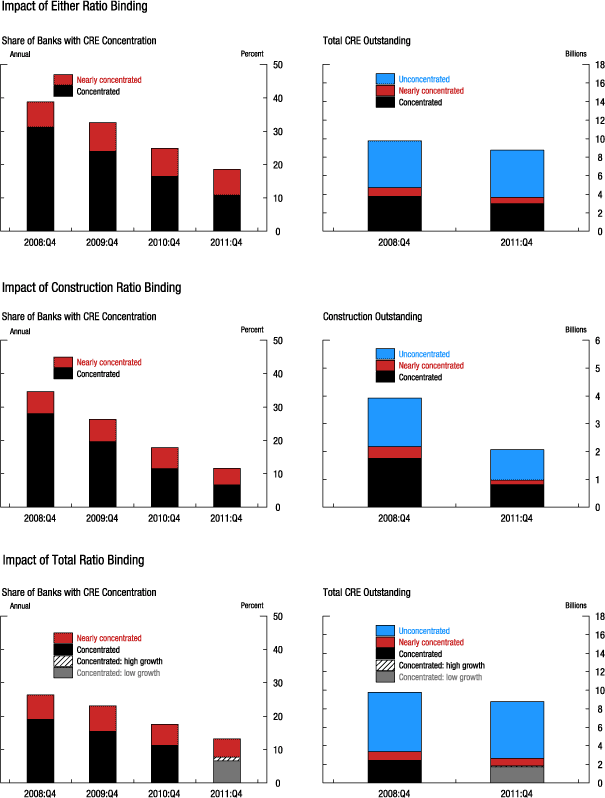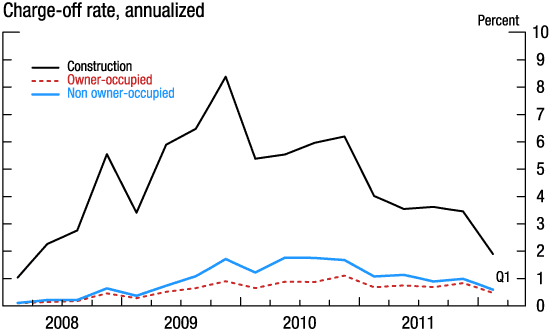An Analysis of the Impact of the Commercial Real Estate Concentration Guidance
- Part 1: Executive Summary
- Part 2: Changes in CRE Concentrations over Time
- Part 3: The Impact of CRE Concentrations on Bank Failures
Part 2: Changes in CRE Concentrations over Time
In December 2006, the Board of Governors of the Federal Reserve System, the Federal Deposit Insurance Corporation (FDIC), and the Office of the Comptroller of the Currency (OCC) (collectively, "the agencies") issued interagency guidance, titled "Concentrations in Commercial Real Estate Lending, Sound Risk Management Practices" ("the guidance"). The purpose of the guidance is to address banking institutions' increased concentrations of CRE loans relative to their capital. The guidance reminds institutions that strong risk-management practices and appropriate levels of capital are important elements of sound CRE lending programs, particularly when institutions have concentrations in CRE loans.
As CRE loans begin to account for larger shares of bank loans, the concern is that banks with elevated levels of CRE concentration need to have appropriate risk-management practices in place for the level of exposure in their CRE portfolios. The guidance is meant to reinforce and enhance the agencies' existing regulations and guidelines for real estate lending and loan portfolio management.
The guidance does not establish specific CRE lending limits or caps; rather, it states that an institution exceeding concentration levels may be identified for further supervisory analysis, focusing on the level and nature of the institution's CRE concentration risk. Specifically, the guidance identifies two supervisory criteria that could subject an institution to further analysis:
- Construction concentration criterion: An institution's CLD loan concentration levels represent 100 percent or more of its total risk-based capital (the CLD ratio)
- Total CRE concentration criterion: An institution's total non-owner-occupied CRE loans (including CLD loans), as defined in the guidance, represent 300 percent or more of its total risk-based capital (the total ratio), and its non-owner-occupied CRE loans have increased by 50 percent or more during the previous 36 months (the growth component).5
The construction concentration criterion focuses exclusively on CLD loans, as those loans are the most likely to result in losses during a downturn. CLD lending is naturally highly cyclical. Building demand tends to rise quickly when credit availability is high and underwriting discipline relaxes, then contracts sharply during downturns.Figure 1 compares banks' net charge-off rates for construction loans, owner-occupied CRE loans, and non-owner-occupied CRE loans. Clearly, construction loans have had much higher loss rates during the recent market downturn. Loss rates for non-owner-occupied loans, while still higher than loss rates for owner-occupied loans, were significantly lower than those for construction loans.
The guidance does not state that the supervisory criteria should be viewed as a hard cap on CRE concentration levels. Institutions are permitted to maintain CRE concentration levels above the levels as defined in the supervisory criteria, as long as the institutions can document heightened risk-management practices related to their CRE portfolios. These heightened risk-management practices may include stress tests, although the sophistication level of the stress tests should be appropriate for the institution's size.
The guidance's goal is not to discourage banks from responding to demand for credit. Rather, the goal is to address concerns that banks entering the CRE market and rapidly increasing their CRE concentration levels might not have the institutional knowledge, well-developed and documented risk-management practices, or capital necessary to address the increase in CRE risk exposures. CRE concentration levels at banks have steadily increased in the past two decades, increasing banks' exposures to the unique risks associated with CRE lending. The recession period reveals again the cyclical nature of the CRE market. Excessive CRE concentrations pose a threat even to banks with good risk practices and above-average capital, particularly in the most overheated markets that were the hardest to fall. The recession also revealed that, while good risk-management practices and above-average capital are essential to mitigate risks associated with high CRE concentrations, they may not be sufficient to prevent bank failure.
Applying the Interagency Guidance
In figure 2, we use bank-level call report data to illustrate how banks' CRE concentration levels have changed since 2008 relative to the supervisory criteria.6 The two bar charts in the top panel of figure 2 illustrate how applying either of the two criteria affects
- the percentage of banks close to or exceeding the concentration levels and
- the amount of outstanding CRE loans held by banks when sorted by concentration levels of CRE lending
The middle and bottom panels of figure 2 apply the criteria separately--by construction concentrations and by total CRE concentrations, respectively. For both the construction and total ratios, the sample of banks is divided into three categories: (1) banks are considered concentrated if their ratios are above the concentration levels (300 percent or 100 percent, respectively); (2) banks are considered nearly concentrated if their ratios are close to the concentration levels (between 250 and 300 percent or between 80 and 100 percent, respectively); and (3) banks are considered unconcentrated if their ratios are not close to the levels set in the guidance (less than 250 percent or less than 80 percent, respectively).
In figure 2, the pair of charts in the top panel shows the effect of having either ratio binding. As shown in the top chart at left, almost 40 percent of all commercial banks in 2008 had at least one of the ratios close to or above the thresholds. By the fourth quarter of 2011, this number had fallen to less than 20 percent. As shown in the top chart at right, banks above at least one of the thresholds held $378 billion in, or 40 percent of, outstanding CRE loans in 2008, and $298 billion, or 34 percent, in 2011.
While there has been a significant reduction in the number of banks close to or above at least one of the thresholds, banks that remain close to or exceeding the thresholds still account for nearly half of all outstanding CRE loans. We believe this indicates that there is a core group of banks that specializes in, or is particularly dependent on, CRE lending. Many banks with high concentrations that managed to survive the recession benefitted from being outside the most overheated and affected markets. This likely was not the case for all surviving banks, which suggests that at least some of them were able to effectively manage the risks of holding concentrated CRE portfolios, including by employing risk management practices that satisfy the demands of the guidance.
The pair of charts in the middle panel of figure 2 repeats this analysis based solely on the construction ratio. The definitions of concentrated, nearly concentrated, and unconcentrated here depend only on the ratio of CLD loans to total capital. The chart at left shows that the share of banks with ratios above or near 100 percent declined from 35 percent in 2008 to 11 percent in 2011. The chart at right illustrates sharp declines in both the total amount of CLD loans outstanding (from $392 billion in 2008 to $207 billion in 2011) and the share of those loans held by banks near or above the construction ratio (from 55 percent to 47 percent). Almost all of the banks (97 percent) that saw their ratios fall from above 100 percent in 2008 to below 100 percent in 2011 did so at least in part by contracting their CLD portfolios. The average decline in the CLD portfolios for these banks was 51 percent. Roughly half of these banks also saw increases in their capital, with an average change of 22 percent.

The bottom panel of figure 2 repeats the analysis based solely on the total non-owner-occupied CRE ratio. As shown in the two upper panels, 27 percent of banks holding 35 percent of outstanding CRE loans had a total ratio close to or above the concentration level set in the guidance in 2008, compared with only 14 percent and 30 percent, respectively, in 2011. When the additional growth component--growth of 50 percent or more in CRE loans over the previous 36 months--is applied to the 2011 data, however, the criteria are applicable for less than 2 percent of banks, which hold 2 percent of the outstanding CRE loans in 2011. When the growth component is incorrectly applied--by excluding the additional requirement for growth of 50 percent or more in the CRE portfolio during the previous 36 months--a significant number of additional institutions are misidentified as subject to the guidance. As we observed with the construction ratio, most of the banks (91 percent) that saw their ratios fall from more than 300 percent to less than 300 percent accomplished this at least in part by shrinking the size of their total CRE portfolios, with an average decline of 24 percent. Many of these banks (45 percent) also reduced this ratio by increasing their capital, by an average of 30 percent.
Growth in capital and contraction in CRE portfolios, particularly among CLD loans, contributed to an overall decline in CRE concentrations over the period. The average construction concentration ratio fell from 77 percent in 2008 to 38 percent in 2011. The total ratio saw a much less dramatic decline, from 177 percent to 141 percent, over the same period. Much of the decline in the total ratio is due to shrinking CLD portfolios. Despite these declines in concentration, a significant number of banks remain heavily concentrated in CRE loans, and exposure to non-CLD CRE loans in particular remains high.
References
5. Owner-occupied CRE loans were not broken out by financial institutions in call report data until 2007; therefore, it was not possible to accurately measure the three-year growth rate of an institution's non-owner-occupied CRE portfolio--and correctly apply the growth component--until late 2010. Given this data limitation, we use a measure of the second criteria without this condition applied in the historical analysis in this paper; however, it is important to recognize the growth component as laid out in the guidance. The appendix provides details on ratio calculations using call report definitions. Return to text
6. The appendix to this report provides instructions for correctly calculating the supervisory criteria using the post-2007 call report definitions. Return to text

